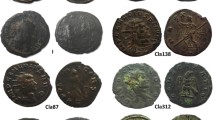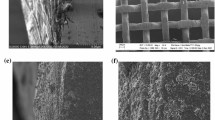Abstract
A methodology for characterizing archeological gold embroidery threads based on two analytical techniques is described: Field emission scanning electron microscopy (FESEM-EDX) and voltammetry of immobilized microparticle (VIMP) methodologies. After the analysis of the chemical composition of the metallic foil, we analyze specific voltammetric features associated with the oxidation of gold in contact with aqueous H2SO4 and HCl electrolytes. Cyclic and square wave voltammetries (VMP) have been used to get information about the elemental composition and the corrosion products of the samples. AFM, FESEM-EDX, and FESEM-FIB-EDX methodologies complete the study and bring us closer to the composition of the alloys and the embroidery manufacture techniques. This technique actualizes the VIMP data and evidences the morphological and elemental differences between them; in particular, it is confirmed that Au-Ag-Cu alloys, with notably differences in Ag content depending on the provenance, were used.












Similar content being viewed by others
References
Járó M (2003). Metal threads in historical textiles, in Molecular and structural archaeology: Cosmetic and therapeutic chemicals, Centre de Recherche et de Restauration des Musées de France, Paris, pp 163−178
Gleba M (2008) Auratae vestes: Gold textiles in the ancient Mediterranean, in Vestidos, Textiles y Tintes: Estudios sobre la produccion de bienes de consumo en la antigüedad, Proceedings of I Symposium Internacional sobre textiles y tintes del Mediterráneo en época romana, 2002. Consell Insular d‘Eivissa i Formentera and Universitat de Valencia,pp 63−80
Járó M (1990) Gold embroidery and fabrics in europe: XI–XIV centuries. Gold Bull 23(2):40–57
Karatzani A (2007) The evolution of a craft: the use of metal threads in the decoration of late and post Byzantine ecclesiastical textiles. University of London, London
Járó M (1995) Manufacturing technique of gold threads and their imitations on museum textiles-chronology of the preparation of metal threads. Results of the scientific investigations in Endrei W, Ed. Yearbook of the Textile Museum, Budapest, pp 31−51
Nord AG, Tronner K (2000) A note on the analysis of gilded metal embroidery threads. Stud Conservat 45:274–279
Tronner K, Nord AG, Sjöstedt J, Hydman H (2002) Extremely thin gold layers on gilded silver threads. Stud Conservat 47:109–116
Hoke E, Petrascheck-Heim I (1977) Microprobe analysis of gilded silver threads from mediaeval textiles. Stud in Conservat 22:49–62
Indictor N, Koestler RJ, Blair C, Wardwell A (1988) The evaluation of metal warppings from medieval textiles using scanning electron microscoopy-energy dispersive X-ray spectrometry. Text Hist 19(1):3–22
Indictor N, Koestler RJ, Wypyski M, Wardwell AE (1989) Metal threads made of proteinaceous substrates examined by scanning electron microscopy-energy dispersive x-ray spectrometry. Stud Conservat 34:171–182
Karatzani A (2006). Metal threads: the historical development. Proceedings ISA: 444.09−444.19
Járó M, Toth A, Gondar E (1990) Determination of the manufacturing technique of a 10th century metal thread. ICOM Committee for Conservation, 9th triennial meeting, Dresden, German Democratic Republic. ICOM Committee for Conservation, pp 299−301
Enguita O, Climent-Font A, García G, Montero I, Fedi ME, Chiari M, Lucarelli F (2002) Characterization of metal threads using differential PIXE analysis. Nucl Inst Methods Phys Res B 189(1-4):328–333
Balta ZI, Csedreki L, Furu E, Cretu I, Huszank R, Lupu M, Torok Z, Kertesz Z, Szikszai Z (2015) Ion beam analysis of golden threads from Romanian medieval textiles. Nucl Inst Methods Phys Res B 348:285–290
Pascual-Pacheco J (1992) La necrópolis islámica de l’Almoina (Valencia). Primeros resultados. III CAME, Actas 2:406−412
Pascual-Pacheco J, Serrano-Marcos ML (1996) Necrópolis islámicas en la ciudad de Valencia. Saitabi 46:231–252
Ferragud-Adam X, Piquero-Cilla J, Doménech-Carbó MT, Guerola Blay V, Company X, Doménech-Carbó A (2017) Electrochemical analysis of gildings in Valencia altarpieces: a cross-age study since 15th until 20th century. J Solid State Electrochem 21:1477–1487
Constantinescu B, Vasilescu A, Radtke M, Reinholz U (2010) Micro-SR-XRF studies for archaeological gold identification—the case of Carpathian gold and Romanian museal objects. Appl Phys A Mater Sci Process 99(2):383–389
Antonelli F, Lazzarini L, Cancellere S, Tesser E (2016) Study of the deteriortion products, gilding, and polychromy of the stones of the Scuola Grande Di San Marco’s façade in Venice. Stud Conserv 61(2):74–85
Gulotta D, Goidanich S, Bertoldi M, Bortolotto S, Toniolo L (2012) Gildings and false gildings of the baroque age: characterization and conservation problems. Archaeometry 54(5):940–954
Scholz F, Meyer B (1998) Voltammetry of solid microparticles immobilized on electrode surfaces, Electroanalytical chemistry, a series of advances. Bard AJ, Rubinstein I, Eds., Marcel Dekker, New York, vol. 20, pp 1−86
Scholz F, Schröder U, Gulaboski R, Doménech-Carbó A (2014) Electrochemistry of immobilized particles and droplets, 2nd edn. Springer, Berlin-Heidelberg
Doménech-Carbó A, Labuda J, Scholz F (2013) Electroanalytical chemistry for the analysis of solids: characterization and classification (IUPAC Technical Report). Pure Appl Chem 85:609–631
Doménech-Carbó A, Doménech-Carbó MT, Costa V (2009) Electrochemical methods in archaeometry, conservation and restoration. Monographs in electrochemistry series, Scholz F, Ed. Springer, Berlin-Heidelberg
Doménech-Carbó A (2010) Voltammetric methods applied to identification, speciation and quantification of analytes from works of art: an overview. J Solid State Electrochem 14(3):363–369
Doménech-Carbó A (2011) Tracing, authentifying and dating archaeological metal using the voltammetry of microparticles. Anal Methods 3(10):2181–2188
Burke LD, Nugent PF (1997) The electrochemistry of gold: I the redox behaviour of the metal in aqueous media. Gold Bull 30(2):43–53
Chen A, Lipkowski J (1999) Electrochemical and spectroscopic studies of hydroxide adsorption at the Au(111) electrode. J Phys Chem B 103(4):682–691
Hoogvliet JC, van Bennekom WP (2001) Gold thin-film electrodes: an EQCM study of the influence of chromium and titanium adhesion layers on the response. Electrochim Acta 47(4):599–611
Burke LD, O'Mullane AP (2000) Generation of active surface states of gold and the role of such states in electrocatalysis. J Solid State Electrochem 4(5):285–297
Burke LD, O’Mullane AP, Lodge VE, Mooney MB (2001) Auto-inhibition of hydrogen gas evolution on gold in aqueous acid solution. J Solid State Electrochem 5(5):319–327
Doyle RL, Lyons MEG (2014) The mechanism of oxygen evolution at superactivated gold electrodes in aqueous alkaline solution. J Solid State Electrochem 18(12):3271–3286
Jeyabharathi C, Hasse U, Ahrens P, Scholz F (2014) Oxygen electroreduction on polycrystalline gold electrodes and on gold nanoparticle-modified glassy carbon electrodes. J Solid State Electrochem 18(12):3299–3306
Jeyabharathi C, Ahrens P, Hasse U, Scholz F (2016) Identification of low-index crystal planes of polycrystalline gold on the basis of electrochemical oxide layer formation. J Solid State Electrochem 20(11):3025–3031
Izumi T, Watanabe I, Yokoyama Y (1991) Activation of a gold electrode by electrochemical oxidation-reduction pretreatment in hydrochloric acid. J Electroanal Chem Interfacial Electrochem 303(1-2):151–160
Scholz F, López de Lara González G, de Carvalho LM, Hilgemann M, Brainina Kh Z, Kahlert H, Jack RS, Minh DT (2007) Indirect electrochemical sensing of radicals and radical scavengers in biological matrices. Angew Chem Int Ed 46(42):8079–8081
Nowicka A, Hasse U, Sievers G, Donten M, Stojek Z, Fletcher S, Scholz F (2010) Selective knockout of gold active sites. Angew Chem Int Ed 49(17):3006–3009
Hasse U, Fricke K, Dias D, Sievers G, Wulff H, Scholz F (2012) Grain boundary corrosion of the surface of annealed thin layers of gold by OH·radicals. J Solid State Electrochem 16(7):2383–2389
Hasse U, Wulff H, Helm CA, Scholz F (2013) Formation of gold surfaces with a strongly preferred {100}-orientation. J Solid State Electrochem 17(12):3047–3053
Cepriá G, Abadías O, Pérez-Arantegui J, Castillo JR (2001) Electrochemical behavior of silver-copper alloys in voltammetry of microparticles: a simple method for screening purposes. Electroanalysis 13(6):477–483
Doménech-Carbó A, Doménech-Carbó MT, Pasíes T, Bouzas MC (2012) Modeling corrosion of archaeological silver-copper coins using the voltammetry of immobilized particles. Electroanalysis 24:1945–1955
Capelo S, Homem PM, Cavalheiro J, Fonseca ITE (2013) Linear sweep voltammetry: a cheap and powerful technique for the identification of the silver tarnish layer constituent. J Solid State Electrochem 17:223–234
Doménech-Carbó A, Del Hoyo-Meléndez JM, Doménech-Carbó MT, Piquero-Cilla J (2017) Electrochemical analysis of the first Polish coins using the voltammetry of immobilized particles. Microchem J 130:47–55
Jeyabharathi C, Hodnik N, Baldizzone C, Meier JC, Heggen M, Phani KLN, Bele M, Zorko M, Hocevar S, Mayrhofer KJJ (2013) Time evolution of the stability and oxygen reduction reaction activity of PtCu/C nanoparticles. ChemCatChem 5(9):2627–2635
Meier JC, Galeano C, Katsounaros I, Topalov AA, Kostka A, Schuth F, Mayrhofer KJJ (2012) Degradation mechanisms of Pt/C fuel cell catalysts under simulated start–stop conditions. ACS Catal 2(5):832–843
Meier JC, Katsounaros I, Galeano C, Bongard HJ, Topalov AA, Kostka A, Karschin A, Schuth F, Mayrhofer KJJ (2012) Stability investigations of electrocatalysts on the nanoscale. Energy Environ Sci 5(11):9319–9330
Martí-Villaba M, Davis J (2008) New directions for carbon-based detectors: exploiting the versatility of carbon substrates in electroanalysis. J Solid State Electrochem 12:1245–1254
Noked M, Soffer A, Aurbach D (2011) The electrochemistry of activated carbonaceous materials: past, present, and future. J Solid State Electrochem 15(7-8):1563–1578
Kang F, Leng Y, Zhang T-Y, Li B (1998) Electrochemical synthesis and characterization of ferric chloride-graphite intercalation compounds in aqueous solution. Carbon 36(4):383–390
Urbaniak J, Skowronski JM, Olejnik B (2010) Preparation of Fe2O3-exfoliated graphite composite and its electrochemical properties investigated in alkaline solution. J Solid State Electrochem 14(9):1629–1635
Herrera-Gallego J, Castellano CE, Calandra AJ, Arvia AJ (1975) The electrochemistry of gold in acid aqueous solutions containing chloride ions. J Electroanal Chem 66(3):207–230
Doménech-Carbó A, Scholz F, Schmitt RT, Usera J, García-Forner AM, De l F-A, Jeyabharathi C, Piquero-Cilla J, Montoya N (2017) Electrochemical characterization of natural gold samples using the voltammetry of immobilized particles. Electrochem Commun 85:23–26
Acknowledgements
The authors would like to thank the Servei d’Investigació Arqueològica Municipal de València (SIAM) for the access to the samples. The authors also wish to thank Dr. José Luis Moya López, Mr. Manuel Planes Insausti, and Mrs. Alicia Nuez Inbernón (Microscopy Service of the Universitat Politècnica de València) for the technical support.
Funding
Projects CTQ2014-53736-C3-1-P and CTQ2014-53736-C3-2-P, which are supported with Ministerio de Economía, Industria y Competitividad (MINECO), and Fondo Europeo de Desarrollo Regional (ERDF) funds, as well as project CTQ2017-85317-C2-1-P supported with funds from MINECO, ERDF, and Agencia Estatal de Investigación (AEI), are gratefully acknowledged.
Author information
Authors and Affiliations
Corresponding author
Rights and permissions
About this article
Cite this article
Martínez, B., Piquero-Cilla, J., Montoya, N. et al. Electrochemical analysis of gold embroidery threads from archeological textiles. J Solid State Electrochem 22, 2205–2215 (2018). https://doi.org/10.1007/s10008-018-3927-x
Received:
Revised:
Accepted:
Published:
Issue Date:
DOI: https://doi.org/10.1007/s10008-018-3927-x




